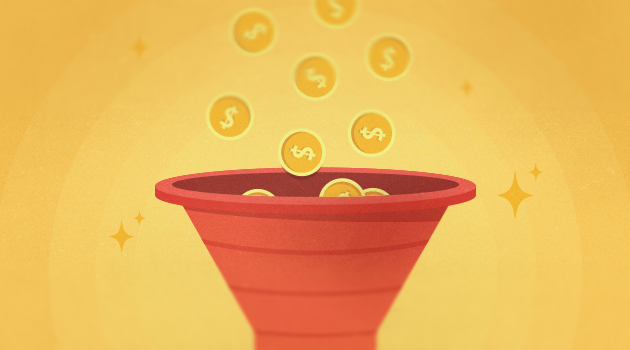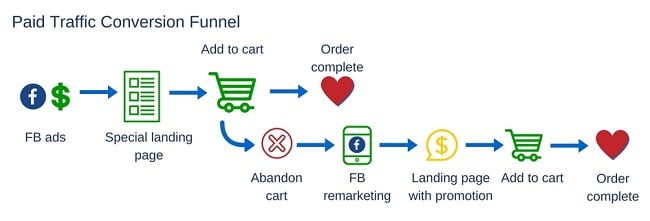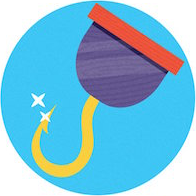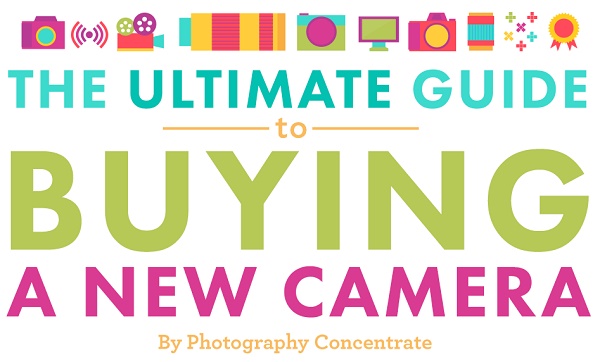
3 Ecommerce conversion funnels: Practical guide
Conversion funnels are one of these concepts that everyone knows about and uses, but doesn’t explore in detail. Every online store has a conversion funnel in place and yet we rarely break it down to the core.
Why should we?
Because that’s probably the most important mechanism you use for getting sales – advertising, on-site-experience, engagement and remarketing are all parts of this process.
In this article, we break down examples of eCommerce conversion funnels and show you what to look for at each stage.
This process should be a major part of the eCommerce performance analysis and reporting you do. This way, you’ll not just detect when something breaks but catch the particular part of the ecommerce funnel that’s underperforming.
Types of ecommerce funnels:
- paid traffic conversion funnel
- content marketing (inbound marketing) funnel
- organic social media funnel
Plus, we’ll talk about the types of ecommerce funnels fit for various purposes.
Conversion funnels in eCommerce
People won’t simply land on your website and purchase something, right?
There is a sequence of steps that they go through before finalizing the order. We’ll look at that process of leading visitors to the desired outcome – purchase – and hopefully, you’ll have your conversion funnel(s) ready or improved by the end of this article.
New to CRO? Here’s a complete guide to conversion optimization for online stores.
Conversion Funnel Step 1: Acquisition
Obviously, without traffic to your store, you can’t be selling. How you acquire customers should be aligned with their habits, preferred channels and response to different stimuli.
Reddit is an awesome channel but not for every product. Also, Facebook is the go-to channel, but some target groups are not very active there and don’t respond to promotions there.
If you feel that it is time for some inspiration, check out our case study on acquisition with the Yumi store.
Conversion Funnel Step 2: Activation
Visitors don’t convert right away. They need to browse around, engage with your site, get to know you before they’re ready to give you any money.
To lead visitors through the process toward the end goal, design a flow that encourages small, manageable actions at each step. This approach not only builds familiarity with your site but also creates a sense of trust as they move forward. For example, sites like japancasino.ltd effectively use this strategy by gradually introducing features and benefits, guiding users without overwhelming them, and ultimately leading them to make informed decisions with ease. By implementing such a flow, visitors feel more comfortable engaging with your content rather than feeling rushed to make a purchase.
This is activation. You lead them to take an action such as reading your blog, subscribing for email offers or browsing through your lookbooks. All that matters is that they’re spending time on your site.
Conversion Funnel Step 3: Desire
96% of the people who land on your site are not ready to buy yet. A big portion of them won’t even have the desire to purchase your products.
People need to reach the point of desire independently. As one of the most popular sayings in marketing goes, “Nobody likes being sold to. They like to buy, but not being sold to.”
That’s why your ecommerce funnel should go gently and create that feeling naturally. For example, inbound marketing focuses on supplying valuable/ entertaining resources for the target audience to enjoy, which transfers into positive feelings for the brand and products as well.
Conversion Funnel Step 4: Purchase
The Holy Grail. The end goal. What we’re all in it for.
However, getting people to that goal depends on everything up until now. The steps are interlinked and each one should build on the previous, using what you’re learning along the way: people respond well to email marketing so you should not move them away from their comfort zone, for instance.
So now, how should you build your ecommerce funnels to work through all 4 stages?
We have prepared 3 ready ecommerce sales funnels as examples so you see how flows can go all towards the same goal – orders.
We have a special work cheat sheet for you to fill out as you go along.
Why an online store should have different ecommerce sales funnels
First, one website can convert in more ways than one. No matter how many products you carry, your target customers may vary a lot.
They come to you for different reasons and don’t respond to persuasion in the same way. Visitors should be lead to the desired outcome (a purchase) in a way they are comfortable with. Otherwise, they’ll just drop out.
One target persona is on social media all the time and the other is too busy for that and can be reached through email – but they both still like your product.
Having only one converting ecommerce sales funnel will cut your chances of getting all the people you want.
For example, the same leather bags are not bought by one type of customers only – there are the adventurers who want a buy-it-for-life bag and then there are the yuppies who want to show off with a boutique accessory at the teambuilding.
You need to set up separate shopping experiences for diverse customers and that’s where various ecommerec conversion funnels are needed.
Example ecommerce sales funnels
Although there are many options to add steps and complexity, we’ll examine 3 ecommerce funnel examples that are fit for almost any online store.
Note: We start with acquisition because it varies from segment to segment; also, we may include retention steps. In theory, acquisition and retention are not part of the conversion funnel, but it’s to illustrate how the whole process continues goes – it’s not isolated from everything else.
Another note: Acquisition sources as well as all other steps should be selected because they are suitable for your target group. Don’t just take our advice, adapt it to your needs. For example, if your customers are not on Facebook, rework the ecommerce funnels using better-fitting social media.
Sales funnel 1: Paid traffic
The structure of the ecommerce funnel goes like this:

Facebook ads -> Special landing page -> Add to cart event -> (Order completion) -> Abandon cart -> Facebook remarketing -> Landing page with promotion -> Order completion
Now, let’s look at what goals you should set to measure if the sales funnel is working properly.
Facebook ads
That’s not part of the ecommerce conversion funnel as we noted, but we assume it’s well-targeted and gets the right people in. Click-through-rate (CTR) is the indicator if you manage to grab attention, i.e. your messaging resonates with the target.
The conversion rate of the campaigns will tell you if that’s a channel worth investing in.
Special landing page
Each ad should have a dedicated landing page that repeats the messaging so people don’t feel misled by the ad. It should feed their curiosity, not throw them into a huge product catalog with no clue where to find what caught their eye in the first place. This would result in huge bounce rate.
Another reason for that might be your targeting at the wrong people at the very beginning, which means irrelevant traffic.
Your main goal here is getting them to do the action required – view product category, add to cart right away, etc. If you advertise a new collection, “view” event is ok. If you advertise a single product, you can go straight for the purchase. So measure the rate of action completion.
Also, look at the time spent on page. Although it might be very different for various products and page designs, it shows how fast it gets the visitor to the next step (or loses them).
Add to cart event and checkout completion
The “add to cart” step is optional since you can have instant checkout that forgoes it. Otherwise, those two steps are basic for any sales funnel and that’s why we look at what happens if they’re not completed.
So, in a perfect world, you’d get a 100% conversion rate every time and the ecommerce funnel ends here. In reality, cart abandonment is about 71%.
That’s why you’d have a strategy to fight cart abandonment. AdEspresso says that up to 26% of abandoners can return if you use remarketing.
Facebook remarketing
For precise targeting, use the following events: visitors who started a checkout and didn’t complete an order.
Then again, watch the CTR. The ad and the corresponding landing page should offer a really strong incentive for people to come back – something they missed the first time. According to AdEspresso again, the average CTR for retargeting ads on Facebook is about 10 times the CTR of normal display ads.
And the last thing for that funnel – final conversion rate. Retargeting can get as high as 147% increase of that metric.
Best use of this ecommerce conversion funnel: When you need quick ROI and an instant boost in sales (maybe short-term). For promoting new products or collections.
Sales funnel 2: Inbound Marketing
Here’s how an example inbound marketing funnel would look:

Organic Google search (no purchase intent) -> Resource page -> Pop-up -> Subscribe to blog -> Consume more content -> Browse product pages -> Order -> Continue consuming content
Organic Google search
(Again, the acquisition source is outside the ecommerce funnel, but we look at it for clarity.) The people you want to reach are not in buy-mode all the time and you should have an ecommerce sales funnel dealing with that. Otherwise, you’ll be missing out on all potential customers who don’t go desktop shopping.
Here, you want qualified traffic and ranking for relevant keywords.
What is qualified traffic? It’s traffic from your target group, people who fit your target customer profile. It’s true that the more traffic, the better in general.
However, not any traffic will convert to customers so it’s not worth pushing in people who were never interested in your products to begin with.
As for the relevant keywords, the Shopify blog highlights that surrounding your core terms with context gives Google a better understanding of your site. And also that it’s an ongoing process because the way people call and search for things change. Read the whole guide to dealing with keywords for ecommerce here.
Resource page
This can be an article, graphics, an e-book, a guide, etc. It’s a piece of informational or entertaining value to your target group. If you sell hiking gear, articles on outdoor survival tricks and not-so-popular trails to explore would be nice traffic generators. Those pieces of content don’t push products, they cover topics close to the use of your products.
See also: Inbound Marketing for Ecommerce business
To see how well your content is working, look at:
- traffic – if your inbound efforts are being discovered and interesting
- bounce rate – It’s not so bad as with paid ads because here people can use the resource and leave, but then return after some time for more content or a purchase. It’s good to keep them on the site for longer (more chances to make them love your brand), but still it’s a long-term strategy so don’t fret too much. Just create high-quality pieces so they stick to the mind.
- average time per session – It indicates how much attention visitors paid to the pieces. Only don’t get carried away – if the text is about a 1000 words and they spent 20 minutes on it, it’s not real, they probably just didn’t close the tab.
- pages per session – That one is the opposite of bounce rate. A lower number doesn’t necessarily signal defeat. People really come for a certain type of information sometimes and are gone as soon as they get it. It doesn’t mean you’ve lost them.
Also, if you hope to build a lifestyle brand with a lively community, you’ll need lots of (diverse) content so they stay on your website for hours. For example, Mint.com managed to fight and win in the harsh personal finance industry by focusing on educational content. It naturally led people to the conclusion they needed the Mint service.
Read more: Ecommerce content marketing examples
Pop-up & Subscribe for blog
Since content is this sales funnel’s fuel, you need to keep people in the loop. Occasional landing on resources is one thing, being able to reach them any time is another.
So your goal here is to get them to subscribe to receive your new content, newsletter, research, recipes or whatever form you use. It’s the action you need them to take to get to the next step of the ecommerce funnel.
Consume more content
The fact that those people keep engaging with your content is a good sign of interest. The same measures that tell if they actually read/ watch the pieces apply as in the first step of the funnel.
If you send them emails (newsletter), goals would be opens and clicks, and unsubscribe rate. You aim at keeping them interested so your brand stays top-of-mind.
Browse product pages
At some point, when your “content consumer” are ready to buy, they move away from your free resource pages and look around your products.
How many sessions they make and how much time they spend looking at your products shows if they’re truly considering to order from you. If they never make it beyond the first page, though, write them off. The conversion funnel didn’t work on them – maybe they didn’t quite fit your target profile (topics of interests – yes, budget – no).
The best case scenario is they start checking your product offerings just like they consume your content. That’s how the interest is transferred onto the brand.
Order
Reaching this step of the funnel means your inbound marketing efforts work as intended. Free information converts into sales. Some studies say the average conversion rate you can expect from Inbound Marketing is 3.82%.
As mentioned, this ecommerce funnel is longer in time so it’s expected that it gets more traffic at the top and gives results over time. So be patient and invest in quality content. 🙂
Continue consuming content
Also not part of the traditional sales funnel, but it’s important to say that customers converted through different ecommerce marketing funnels should be retained via different tactics as well. This shapes distinctive – and positive – experience because it uses only methods they respond well to.
Once customers buy as a result of Inbound Marketing, you should keep providing them with value the same way. That’s what they appreciate so you don’t have to come up with new tricks. Keep up the image.
Best use of this funnel: For creating brand awareness and establishing yourself in the mind of the target audience long-term.
Conversion funnel 3: Organic Social Media presence
The last ecommerce sales funnel we’ll explore is one combining organic engagement on social media and product-pushing content.

Social Media presence -> Engage with posted content linking to products -> No action towards order -> Social Media remarketing -> special product page -> order
Social Media presence
As part of your social media activity, you may have pieces of content that sell harder than others. Especially around holidays, buying guides are one format that converts very well because they help people already in buying mode.
It works when you share such a piece with your audience and it gets good traffic and engagement.
Engage with posted content linking to products
If people feel you only preformatted your category page with a Christmas theme, it won’t work. You have to be helpful even when you hard-sell.
Low bounce rate is the first signal if you do it right. And don’t worry, rates between 20% and 45% are normal for eCommerce sites. Also, blogs have even higher expected average bounce rate of around 65% so you have quite a wide range to breathe.
Dwell time is second. Adding more information about the items (than you have on a product page) will make people read longer. Focusing on different features and uses for the various target readers increases your chances even more. You can target all your segments with the same product, presented differently.
Lastly for this step, make sure you have a clear call to next action. What do you want them to do? Go to product page and order? Watch a demo? Talk to a consultant? The completion of this action is the measure of success of this step.
Social Media remarketing
Of course, it’d be great if visitors convert from this one piece of content right away.
But if they don’t, following up on the same social channel is necessary. The good thing is people have already seen your products so the ad copy can bring the same to the front.
A high Click-through rate will indicate that they’re more willing to buy now after (consciously or not) considering your suggestions from the guide. Plus, people like the familiar so it’s important to remain visible while they’re deciding.
Special product page
Don’t forget you need dedicated landing pages for your ads that keep the same focus and guide the visitor to a very specific action. This is where you finally get your order – and conversion rate.
In this particular ecommerce funnel, we recommend a non-distracting product page that highlights what the visitor has already seen. You don’t need to throw new info at them.
Consider the following example: they came for a Father’s Day gift – a wallet – and don’t care about the festival safety chain against theft. Their dad is in his mid-50s and knows how not to get mugged.
Best use of this conversion funnel: Educating your audience about all options and uses of your products. Expanding their awareness and highlighting benefits that product pages don’t talk about.
In conclusion
These example marketing sales funnels are far from enough for one online store. But they are one of the basics to rely on.
What we’d like you to take away is that each step needs to be evaluated and perfected because it affects the overall performance of the ecommerce conversion funnel. The good thing is it’s easy to detect the problem when looking at the process step by step instead of just saying, “Well, ads don’t work.” or “My blog doesn’t help at all.”
Try Metrilo for free
Accurate sales attribution and ecommerce stats
Build and grow your ecommerce brand
Metrilo’s mission is to help you build your ecommerce brand and win your place in the customer’s heart. We share what we learn from our daily work with product innovators and founders here. Subscribe to our weekly newsletter to get the freshest lessons and conquer your niche.
We promise, no spam.
Thank you for subscribing!
See you soon :-)





